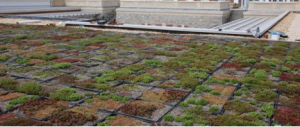When I was in grade school, my science teacher (who was coincidently my mom) played a song for us called Dirt Made My Lunch by The Banana Slug String Band. While I have forgotten most of the lyrics, I remember the main and key theme. We have a lot of gratitude to express to Earth and its soil. Soil sustains us and helps us build life. All soil, however, is not the same. Soils can be affected by what the land is used for and how frequently the land is visited. As the Life in Soils team, we look forward to exploring the biodiversity of these soils and learning more about under Grounds.
As a group, we chose to test three types of sites. We will test some of the gardens in the back of Pavillions, the lawns’ of different frat houses and the green roof on top of Rouss Hall. We hope to see how different social settings, use and ability of access will affect the biodiversity of the soil at these sites.
Garden of Pavillion V
To help us determine the biodiversity, we will both test for signs that show the health of the soil and observe for life. We plan to test soil for its pH levels, moisture content and observed life in the soil.
But what exactly is soil? And why does the pH and moisture content of the soil matter? And why does biodiversity of soil matter?

Fraternity Houses at UVa and their lawns
Well, soil is a general term, which refers to Earth’s outermost layer. Sand, silt and clay compose soil in different proportions. Clay is a key component of the red soil that is very typical of Virginia. The color of soil gives us more information about soil, such as the moisture content and make up of the soil. As bedrock breaks down, this becomes a key component of soil. As well, organic matter is a key component of soil.
pH measures the concentration of hydrogen ions, and the pH scale runs from 0 to 14, with 7 being neutral. The zone of the pH scale that is most conduciveto plant growth would be something from 6 to 7. To determine the pH of soil, a pH meter is used. Over time, soil can become more acidic. One way to help solve the problem of acidic soil is to add lime to the soil. Not only does lime help to raise pH, but it also provides calcium and magnesium, two key elements of soil. Additionally, lime makes phosphorous more readily accessible for plant growth. Lastly, lime helps break down organic matter, which makes more nitrogen available for plant growth. Soil moisture conditions influence how plants will absorb the water from the soil.

Rouss Hall Green Roof
Lastly, biodiversity is important for soil healthy. At the same time, the biodiversity in the soil, shows us the health of the soil. Soil, it is important to remember, is filled with living organisms. These organisms could be microscopic, like bacteria, or the organisms could be larger, like earthworms. This living organisms help to break down the organic matter and make healthier soil. These organisms help to keep the carbon cycle of soil constantly going.
Soil is extremely important. Our team hopes to examine soil at each site and see how it has been affected. By measuring pH, we hope to see what life the soil could provide. Testing the moisture content of soil will help us see how this plays into life in soils. As well, we will keep our eyes open for signs of life by each site. By examining these aspects of soil, we will begin to see the life of soils.
Post by Robert McCarthy
Sources:
https://www.soils.org/discover-soils/soil-basics
https://www.soils.org/discover-soils/soil-basics/what-makes-soil-soi
https://www.soils.org/discover-soils/soil-basics/how-do-soils-form
http://www.esf.edu/PUBPROG/brochure/soilph/soilph.htm
http://www.soils4teachers.org/biology-life-soil
http://www.agriinfo.in/?page=topic&superid=4&topicid=274
Images:
Rouss Hall Green Roof – http://www.greenroofplants.com/projects/viewproject/?projectid=268
